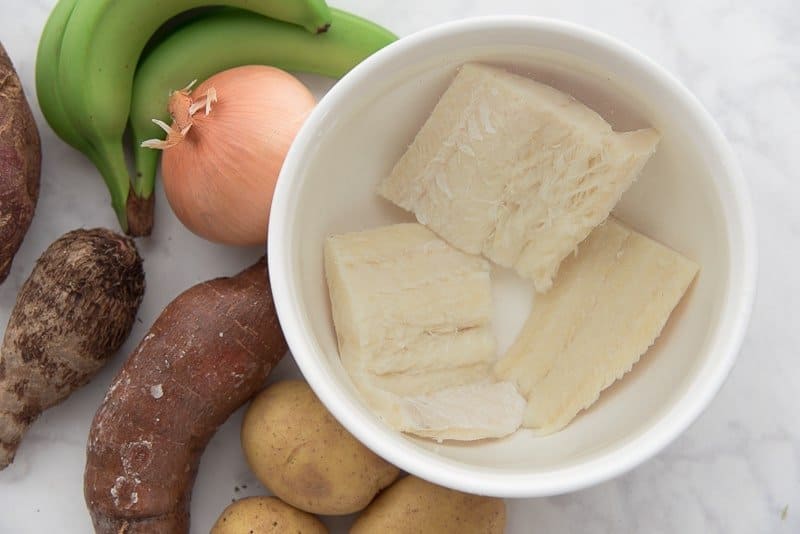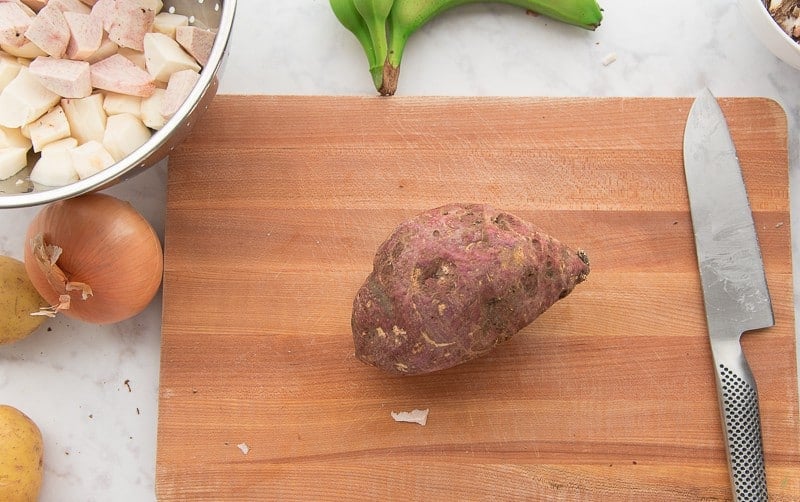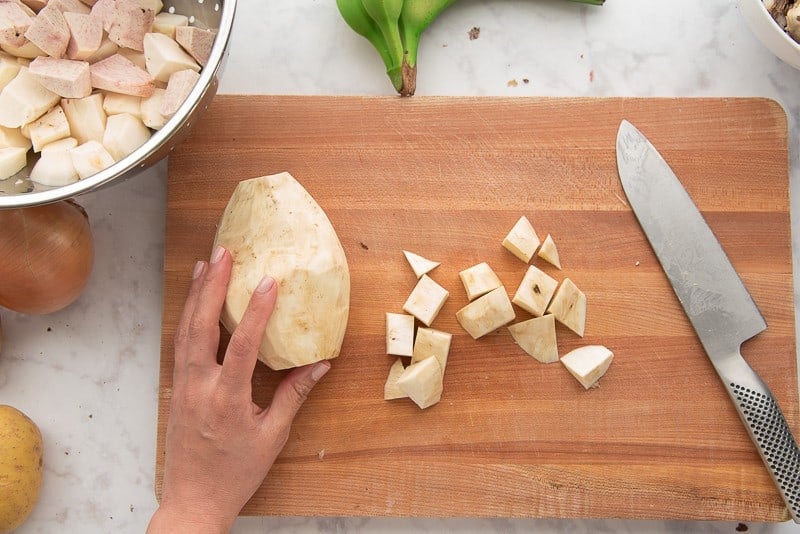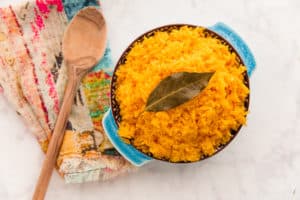Let me sing to you the song of my people! No? Okay, then, let me just “serenade” you with a dish that seems ancestral. Serenata con Viandas is a dish from Puerto Rico that I grew up eating. Again, my mother didn’t have much time to cook, but when she did it seems like she made the food she missed the most. As a result, my siblings and I were exposed to very traditional, “old school” dishes. And you know what? We’re all the better for it.
What is Serenata con Viandas?
Serenata (serenade in English) is a salad made from salted cod that’s been rehydrated, flaked, and tossed together with veggies. The con viandas part of the recipe means “with root vegetables/tubers”. I imagine the name serenata comes from the sound you make when you take your first bite, as well as all other subsequent bites. At least, that’s my impression whenever I eat it.
Serenata has to be one of my favorite recipes from Puerto Rico. Because it now reminds me of my late mother, it’s even more so.
What do I need to make Serenata?
Making this salted codfish dish is as easy as it gets. Grab a pound of salted cod. You can usually find it in the refrigerated case of your grocer’s seafood section. If you’re having a hard time locating it there, head to your local ethnic neighborhood market. Seems like every other culture on the planet eats salted cod in some way, shape, or form. So your bound to find it at ethnic markets.
The remaining ingredients are an abundance root vegetables. Feel free to use a mixture, like I’m using, or stick to things you can pick up locally. Since we have many of the Puerto Rican diaspora in my city, we have an abundance of markets and produce where I can source these ingredients. Do your best finding each as they all should be experienced. But if you can’t find them, double up on what you have access to.
I’m using yuca (not a typo), yellow potatoes (Yukon gold), batata (a white sweet potato), white and red yautía/malanga (taro root), and guineo verde (green, un-gassed bananas). To finish the salad: a quick shred of cabbage (red for color), cherry tomatoes, and thinly sliced onions. A heavy pour of high-quality extra virgin olive oil is all this salad needs in the way of dressing. I add a bit more protein in the form of hard-boiled eggs. Avocado chunks are also used in this salad.
Easy-peasy, right? So, let’s get it.
What’s the deal with salted codfish?
Salted codfish- known as bacalao in most Spanish speaking countries- is probably one of the most used fish in the Puerto Rican culture. Back in the day, I’m sure a gang of pirates were roving around the seas chompin’ on some cod that had been preserved indefinitely in salt. My experience with codfish is extensive just like the ways you can prepare it. With cod, you can broil, bake, steam, fry, etc. etc. etc. Seriously.
The issue with salted cod, though, is that it must be rehydrated before using it in your recipes. Preparing salted cod for use only requires water. The cod is covered in cold water for 8 hours, which is changed out every 2 hours. That’s the old-school way that I call “long soaking”. I’m about efficiency, so I do a “short soak”. The codfish in cold water for 45 minutes after first rinsing it to remove the exterior salt. After 45 minutes of soaking, I dump that salty water and break up the softened codfish. You can also boil it as is, like we’re going to do with this recipe.
If you find those very dry, hard pieces of salted cod, you may need to extend the soaking process by soaking for 12 hours (long soak) or 2 hours (short soak) changing the water out multiple times during the soaking periods.
Once you’ve extracted that intense amount of salt, you’re ready to go forth and conquer your bacalao recipes.
Which root vegetables should I use?
Lil’ Puerto Rican kiddies learn, very early on, the names of the different tubers (or root vegetables) used in our cooking. Because we’re put to work at a very early age, we’ve probably peeled at least one of these veggies for a meal.
Yautía (taro root) has always been my least favorite to peel because it gets slimy and slippery as you peel it. Guineo verde is my favorite, I have no idea why.The yellow potatoes are the easiest to find, so if that’s all you can get your hands on, use those. Yuca is becoming a popular product in the States, so I doubt you’ll have a difficult time with that. Yautía is also called malanga (it seems the two names are interchangeable depending which island you’re from). You’re more likely to find it by its other name: taro. Finally we have the white sweet potato, or batata. This may be difficult to find outside of an ethnic market. Regular sweet potato may be subbed for it, but it will make the salad a smidge sweeter than normal.
Again, finding these vegetables may be a challenge if you live in an area with a small Hispanic community. I do feel it’s worth it to get out and find them, though. Most major grocery stores have a few of them on hand, albeit, in small amounts. In the event you can’t find all of these vegetables, do what you can with what you can. Use potatoes and yuca. Or, use green bananas and potatoes. The beauty of the way ancestral Puerto Ricans cooked is how they made do with what they could dig out of the ground or pluck from a tree. No biggie.
Yuca
Yuca/ cassava/ manioc is a tuber that’s loved the world over. Don’t let the supermarkets confuse you; yucca the plant and yuca the tuber are two different beasts. One “c” here, people. I don’t know when and where supermarkets here in the States began adding the second “c” to the vegetable, but let’s boycott that.
The yuca we’re talking about is native to South America, but very popular in Africa as well. It has a thick, waxy-peel with a fibrous white flesh. Not to alarm you- hopefully you already know this- but you must cook yuca. It contains a level of cyanide that, if eaten raw, can cause paralysis or even death, but we’re not going to worry about that. Though If anyone ever offers you a “fresh yuca coleslaw”, run!
Yuca flesh is fibrous, so much so, you can see the fibers after boiling the yuca. It has an almost creamy texture, which, in the Serenata we’re making, balances the brininess of the cod fish.
Use a vegetable peeler to remove the thick, waxy skin from the 1/2 lb (one medium-sized) yuca root. Once peeled, use a chef’s knife to cut your yuca into 1″ chunks on your cutting board.
Yautía (Taro Root)
Yautía (yaow-TEEah) is my kitchen nemesis. Stupid as it may sound, I have a thing about slimy and sticky stuff on my hands. Yautía has a dry, husk-like skin that’s fairly easy to remove. Once you hit the white (or speckled red) flesh, that’s when the slime kicks in. I’m being a total baby about it. You’re more of a trooper, so it won’t be as bad to you.
Once you’ve peeled the yautía cut it into the same size chunks as you cut the yuca. You’ll notice in the images above, I’m just popping the cut vegetables into a colander because I intend to give them a rinse once we’re done prepping them.
Batata (White Sweet Potato)
This, my friends, is called batata. It’s pronounced just like the name looks. Batata is not a yam, it’s also not as sweet as a sweet potato, it’s also not orange. Batata is white, but firm like a regular sweet potato is.
Batata’s are easy to peel, but more difficult to cut than any of the tubers we’re working with. These suckers are hard. My best advice is to slice off a thin layer to anchor your batata and place it on “level ground” so to speak. After that, you can cut the batata into 1″ thick slices, then 1″ thick sticks, and finally down to 1″ thick cubes. Chuck them into the colander with the rest of the veg.
Yellow Potatoes
Potatoes (or papas) are something you’re familiar with. I’m going to assume as much, at least. Peel and cut them into chunks that are the same size as the others.
You’ll notice that I’m peeling and cutting, both, the potatoes and the bananas last. Both of these veggies will brown once cut, so it’s best to wait to cut these last.
Guineos Verde (Green Bananas)
Guineos verdes (ghee-NAY-ohs ver-DAYS), or green bananas, are not unripened bananas. Well, they are but they’re not, they’re not plantains either. Guineos verdes are the same bananas you slice up in your banana pudding. The difference is that these are not gassed to speed up their ripening process like the yellow ones are.
Same animal different gas…wait. That doesn’t sound right. Un-gassed bananas. Anywho!
The best way to peel guineos is to lop off both ends and score the peel down the back of the banana with your knife. Now, if you have a very unripe banana, you may need to give them a quick, 1 minute, dump in boiling water. That will loosen up the peel enough for you to slip it right off.
If you have one that has a little yellow in the peel, it’ll come off sans boiling. Push the fleshy part of your thumb up under the peel and you should be able to remove it easily.
Cut the guineos into 2″ chunks, then slice those chunks in half.
And now we’re ready to roll!
Boil the codfish and root vegetables together
The prep work is the hardest part of this recipe. You’re literally going to throw all of the tubers and the rehydrated, salt-less (not salt free) codfish into a large stock pot.
Fill the pot with enough cold water to allow the veggies to float around. The salt which remains in the codfish will season the tubers, and the rest of the ingredients later added, thus eliminating the need for more salt later on.
Bring the water up to a boil over medium-high heat. Once the water begins to boil, reduce the meat to medium and allow the water to simmer, covered, until the tubers are fork tender. This usually takes about 20 minutes.
Toss the Serenata together
Once your veggies are tender, drain the water off in a colander and transfer the serenata base to a large, non-reactive mixing bowl. Allow it to cool at room temperature for 10 minutes while you prep your cabbage, tomatoes, and onions.
The red cabbage, which is my favorite for adding beautiful color, is thinly sliced- coleslaw-style. If you want to cut down on prep work, grab a bag of that pre-shredded coleslaw stuff in the produce section.
Thinly slice half of an onion- white or yellow- then cut your tomatoes into half-moon slices (for whole tomatoes) or in half for cherry tomatoes like mine.
Add the cabbage, onions, and tomatoes to the bowl with the codfish and tubers. Toss everything together with a pair of wooden salad spoons.
Use a high-quality olive oil
Pour a generous amount of high-quality olive oil- I used Colavita- over the serenata and toss once more.
Your serenata should begin singing to you. If it doesn’t you need to get your ears checked.
To finish the serenata, arrange the salad on a large platter.
Chill the Serenata before serving
Cover the salad in plastic wrap, then store it in the fridge until chilled- about 45 minutes. Serenata is best enjoyed cold, but can be eaten now.
Add hard boiled eggs and avocados
Before serving, cut four hard boiled eggs into quarters and dice 2 avocados. Arrange them around your plated serenata.
The reason for not tossing the eggs and avocado into the salad is to prevent them turning to mush. Plus, it also makes the serenata extra pretty.
Enjoy your serenata with a side of steamed white rice or a thick slice of bread. Leftovers will keep for the next day’s enjoyment, but no longer than 2 days. Beyond that, the avocado will turn brown and slimy.
Pin this recipe for your Lenten meals and be sure it to share it with your friends.

Serenata con Viandas (Codfish Salad with Root Vegetable)
at Sense & EdibilityEquipment
- Colander
- stock pot
Ingredients
- 1 pound salted codfish
- 1 medium yuca root, peeled and cut into 1" chunks
- 2 small white or red yautia/malanga, peeled and cut into 1" chunks
- 1 small batata (white sweet potato), peeled and cut into 1" chunks
- 3 guineos verdes (green bananas NOT plantain), peeled and cut into 1" chunks
- 3 small yellow potatoes, peeled and cut into 1" chunks
- 2 cups thinly shredded red or green cabbage
- 1 cup thinly slice white or yellow onions
- 1/2 dry pint cherry tomatoes, cut in half OR 2 Roma tomatoes, sliced into half moons.
- 1/2-1 cup extra virgin olive oil
- 4 hard boiled eggs, cut into quarters optional
- 2 large ripe avocados, cubed optional
Instructions
Soak the Codfish
- Rinse the codfish under cold, running water to remove excess salt. Place the fish in a large, non-reactive bowl (ceramic, plastic, or glass) and cover it with at least six inches of cold water.
- Long Soaking Method: allow the cod to soak for 4 hours, remembering to change out the water halfway through the soak time. Short Soaking Method: cover the codfish with cold water and allow it to soak for 45 minutes. After 45 minutes of soaking, pour off salty water and break up the softened codfish. You can also boil it as is, like we're going to do with this recipe. (see note for very hard pieces of codfish)
Boil the Codfish and Tubers
- Transfer the yuca, yautía, batata, potatoes, and the guineos verdes, as well as, the rehydrated, salt-less (not salt free) codfish into a large stock pot.
- Fill the pot with enough cold water to allow the veggies to float around. Bring the water up to a boil over medium-high heat. Once the water begins to boil, reduce the meat to medium and allow the water to simmer, covered, until the tubers are fork tender- about 20 minutes.
- Once your veggies are tender, drain the codfish and tubers in a colander. Transfer the serenata base to a large mixing bowl. Allow it to cool at room temperature for 10 minutes.
Toss the Serenata and Dress with Olive Oil
- Add the cabbage, onions, and tomatoes to the bowl with the codfish and tubers. Toss everything together with a pair of wooden salad spoons.
- Pour a generous amount of high-quality olive oil over the serenata and toss once more.
- To finish the serenata, arrange the salad on a large platter.
- Store the salad, covered in plastic wrap, in the fridge until chilled- about 45 minutes. Serenata is best enjoyed cold, but is ready to eat now. Just prior to serving, arrange the boiled egg wedges and avocado chunks around your plated serenata.
- Enjoy your serenata with a side of steamed white rice or a thick slice of bread. Leftovers will keep for the next day's enjoyment, but no longer than 2 days. After that time, the avocado will turn brown and slimy.
Notes
- if you can't locate all of the root vegetables called for in the recipe, use what you can find in you grocery store to substitute them.
- If your codfish has been preserved with a lot of salt and is rock hard, your soaking time should be doubled.
Nutrition
Here are more of my favorite
Puerto Rican recipes:
Arroz Borracho (Drunken Yellow Rice)
Quesitos (Cream Cheese-Filled Pastries)
Pan Sobao (Soft Puerto Rican Bread)




























This is a beautiful and delicious looking salad! I remember having salt fish growing up for breakfast served with a side of fried apples for a sweet and salty combo.
Thanks, Kita! And that combo of apples and codfish sounds amazing!
I don’t think I’ve ever had fish cooked this way. We are HUGE yuca fans and eat fish often, so I’m sure we would love this.
I really think you’ll enjoy it, Heather. It’s such a great dish for Spring and Summer.
A dish that makes you sing? Sign me up! It sounds delicious
Ha ha ha!! Yep! It’s so good it makes you sing!
This looks like an incredible salad! I will have to make this for lunch one day. It looks scrumptious.
I’m glad you think so, Amber!
Well, yet again you’re speaking every single one of my love languages ahaha I absolutely love this recipe!!! Thank you for sharing it! <3
LOL! It’s my pleasure, Aline!
Such a hearty, and healthy salad. I love the abundance of flavor offered from the salt fish. The addition of the yuca and green bananas made it extra flavorful. Awesome variance from your everyday salad!
I think so, too! I like throwing this in the lunch rotation every few weeks to change up the routine.